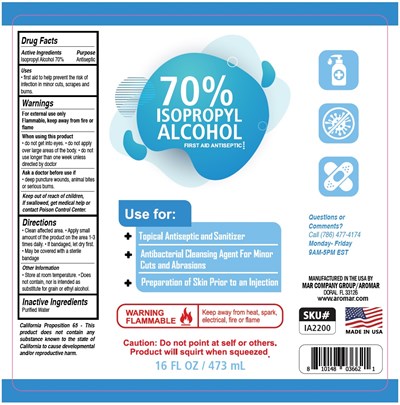Product Images 70% Isopropyl Alcohol First Aid Antiseptic
View Photos of Packaging, Labels & Appearance
Product Label Images
The following 2 images provide visual information about the product associated with 70% Isopropyl Alcohol First Aid Antiseptic NDC 73717-220 by Mar Company Distributors, Llc, such as packaging, labeling, and the appearance of the drug itself. This resource could be helpful for medical professionals, pharmacists, and patients seeking to verify medication information and ensure they have the correct product.
IMAGE - 7371722001

This is a drug fact sheet for a first-aid antiseptic containing 70% isopropyl alcohol to help prevent infection in minor cuts, scrapes, and burns. The product is for external use only and is flammable, so it should be kept away from fire or flame. It is important not to get the product into the eyes or apply it over large areas of the body, and to seek medical attention before using it on deep puncture wounds, animal bites, or serious burns. The product can be applied to the affected area 1-3 times a day and may be covered with a sterile bandage. The product does not contain or intend to substitute grain or ethyl alcohol. The sheet also includes information on inactive ingredients and a cautionary warning. For any questions or comments, customers can call the manufacturer.*
IMAGE - 7371722011

This is an antiseptic first aid product that helps to prevent the risk of infection in minor cuts, scrapes, and burns. It contains 70% isopropyl alcohol and purified water as inactive ingredients. The product should be applied to the affected area, and if necessary, covered with a sterile bandage. It warns not to apply over large areas of the body and also not to get into the eyes. If swallowed accidentally, the user should contact a poison control center or seek medical help immediately. This product is flammable and should be kept away from flame, and it is suitable for topical antiseptic and sanitizer.*
* The product label images have been analyzed using a combination of traditional computing and machine learning techniques. It should be noted that the descriptions provided may not be entirely accurate as they are experimental in nature. Use the information in this page at your own discretion and risk.